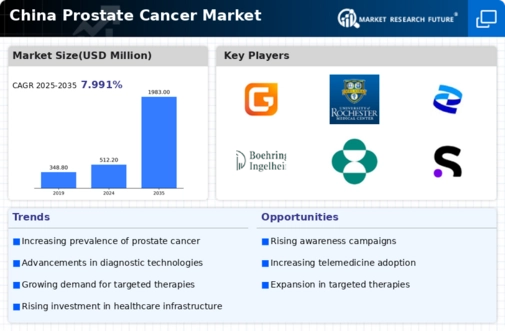Increasing Aging Population
The aging population in China is a critical driver for the prostate cancer market. As life expectancy rises, the number of elderly men, who are at a higher risk for prostate cancer, continues to grow. It is estimated that by 2030, the population aged 60 and above will reach approximately 487 million, representing about 35% of the total population. This demographic shift is likely to lead to an increase in prostate cancer diagnoses, thereby expanding the market. Furthermore, older individuals often require more advanced treatment options, which could further stimulate growth in the prostate cancer market. The healthcare system may need to adapt to accommodate this rising demand, potentially leading to increased investments in research and development for effective therapies.
Rising Healthcare Expenditure
China's rising healthcare expenditure is a substantial driver for the prostate cancer market. The government has been increasing its healthcare budget, aiming to provide better access to medical services and treatments. In 2025, healthcare spending is expected to reach approximately $1 trillion, reflecting a growth rate of around 7% annually. This increase in funding allows for more resources to be allocated towards cancer research, treatment facilities, and patient care. As a result, the prostate cancer market may benefit from enhanced treatment options and improved access to care, ultimately leading to better patient outcomes and increased market growth.
Expansion of Treatment Facilities
The expansion of treatment facilities in China is a notable driver for the prostate cancer market. As the demand for prostate cancer care increases, healthcare providers are establishing more specialized centers dedicated to cancer treatment. This expansion is supported by government initiatives aimed at improving healthcare infrastructure. By 2025, it is anticipated that the number of cancer treatment centers will increase by approximately 15%, enhancing access to care for patients. This growth in facilities not only improves patient access but also fosters an environment conducive to clinical trials and research, potentially leading to the development of new therapies in the prostate cancer market.
Growing Public Awareness Campaigns
Public awareness campaigns regarding prostate cancer are becoming more prevalent in China, which is likely to drive the prostate cancer market. These initiatives aim to educate the population about the risks, symptoms, and importance of early detection. Increased awareness can lead to higher screening rates, resulting in earlier diagnoses and potentially better treatment outcomes. As more men become informed about prostate cancer, the demand for diagnostic and therapeutic services is expected to rise. This shift in public perception may encourage healthcare providers to invest more in prostate cancer-related services, further stimulating market growth.
Technological Innovations in Diagnostics
Technological advancements in diagnostic tools are significantly impacting the prostate cancer market. Innovations such as MRI-guided biopsies and liquid biopsies are enhancing the accuracy of prostate cancer detection. These technologies not only improve early diagnosis but also reduce the need for invasive procedures, which can be a barrier to timely treatment. The market for diagnostic imaging in China is projected to grow at a CAGR of around 10% over the next five years. As healthcare providers increasingly adopt these advanced diagnostic methods, the prostate cancer market is likely to experience growth driven by improved patient outcomes and increased screening rates.





















Leave a Comment